Social media and security dynamics in the ongoing India-China border dispute
False narratives underline dangers posed by disinformation as a means of stoking hostility between nuclear-armed neighbors.
Social media and security dynamics in the ongoing India-China border dispute
Share this story
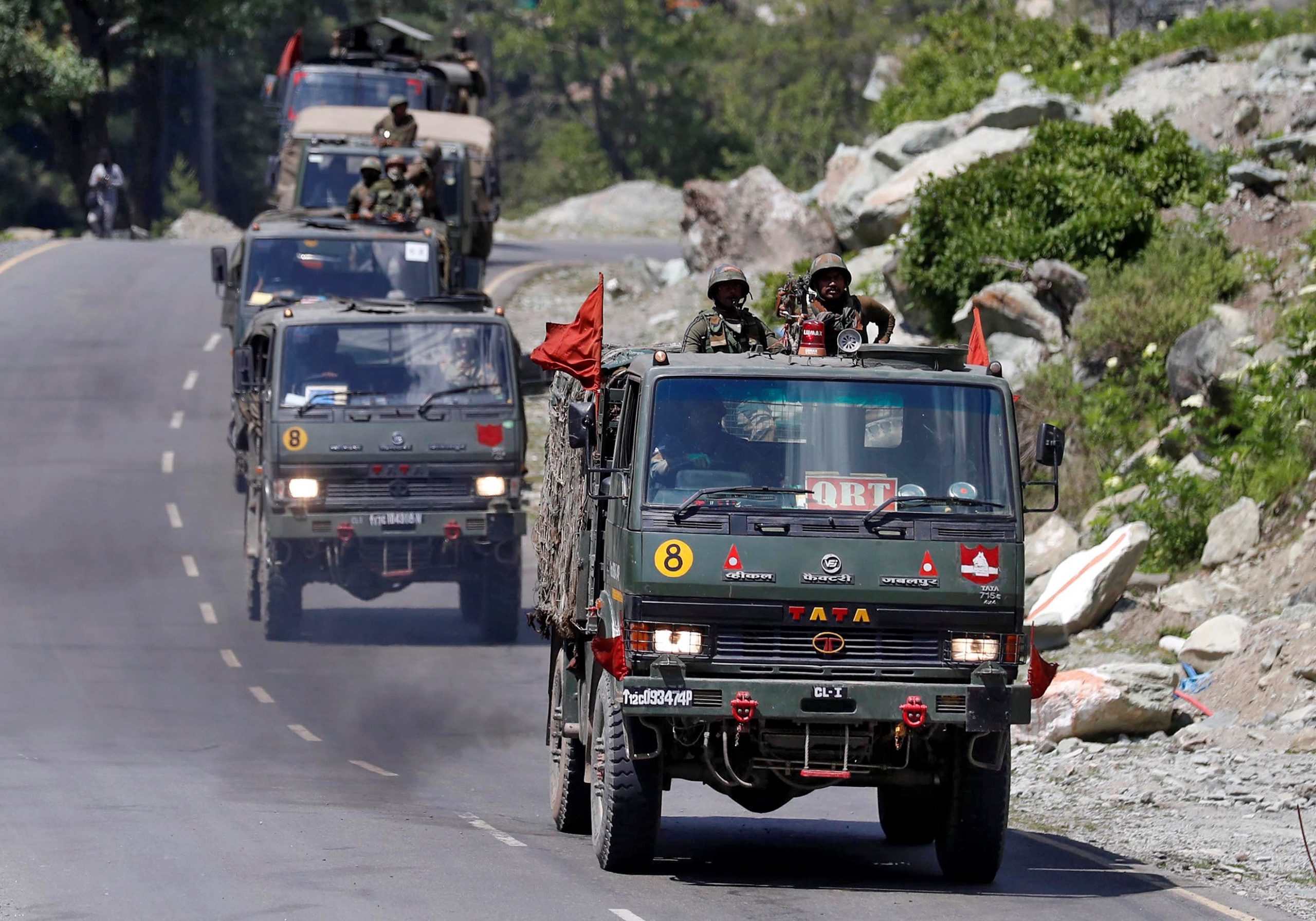
BANNER: An Indian army convoy moves along a highway leading to Ladakh, at Gagangeer in Kashmir’s Ganderbal district, June 18, 2020. (Source: REUTERS/Danish Ismail)
The threat of the ongoing border dispute between India and China escalating into an active conflict between the nuclear-armed neighbors continues to loom large, despite months of sustained diplomatic engagement aimed at ameliorating tensions. As both sides continue to militarize disputed territory along their sides of the border, the DFRLab has tracked a growing incidence of influence operations targeting Indian and Chinese users frequenting major social media platforms that seek to spread false, exaggerated, and hostile narratives surrounding the border dispute. These influence operations frequently occur days ahead of, or during, ongoing diplomatic and kinetic engagements between the two sides, thereby fueling hostility and misperception between the respective populations and likely complicating efforts by policymakers at peacefully resolving the ongoing conflict.
The DFRLab analyzed a series of influence operations targeting Indian users on major social media platforms in the days following the deadly Galwan River Clash on June 15, 2020, when an armed confrontation between Indian and Chinese soldiers in Ladakh led to the death of 20 Indians and an unverified number of Chinese troops. Such information operations serve as a case study in the way social media will continue to exert a disruptive influence on existing inter-state security dynamics and, in doing so, herald the transformation of popular communication services into arenas for geopolitical conflict.
For the second time in less than 18 months, in early October 2021, Indian and Chinese soldiers once again faced off along the two countries highly militarized border. The latest skirmish took place in disputed territory near the Tawang sector bordering the northeastern Indian state of Arunachal Pradesh, which is claimed in its entirety by China. The recent confrontation between soldiers took place ahead of the thirteenth round of Corps Commander level talks to be held by both sides.
New Delhi and Beijing’s broader policies of infrastructure development along the border, as well as the growing militarization of disputed territories in Ladakh and in the northeast, represent powerful drivers of further strategic uncertainty and misperception between decisionmakers in both countries. These trends increase the likelihood of miscalculation or unintentional escalation between Indian and Chinese troops along the Line of Actual Control (LAC), the 3,448 km-long un-demarcated border that divides the two nations. In light of the tense security dynamics at play along the shared border, there is a credible fear that viral falsehoods amplified via social media could help inflame public sentiment, serving as vehicles for stoking hostility and misperception between the nuclear armed neighbors over the long term.
Heightened tensions in the Himalayas
On June 15, 2020, Indian and Chinese soldiers engaged in deadly clashes at the Galwan Valley along the Western section of their un-demarcated and non-delineated border in the Himalayas. This clash represented the most significant spike in tensions between the two countries since they went to war with one another in 1962.
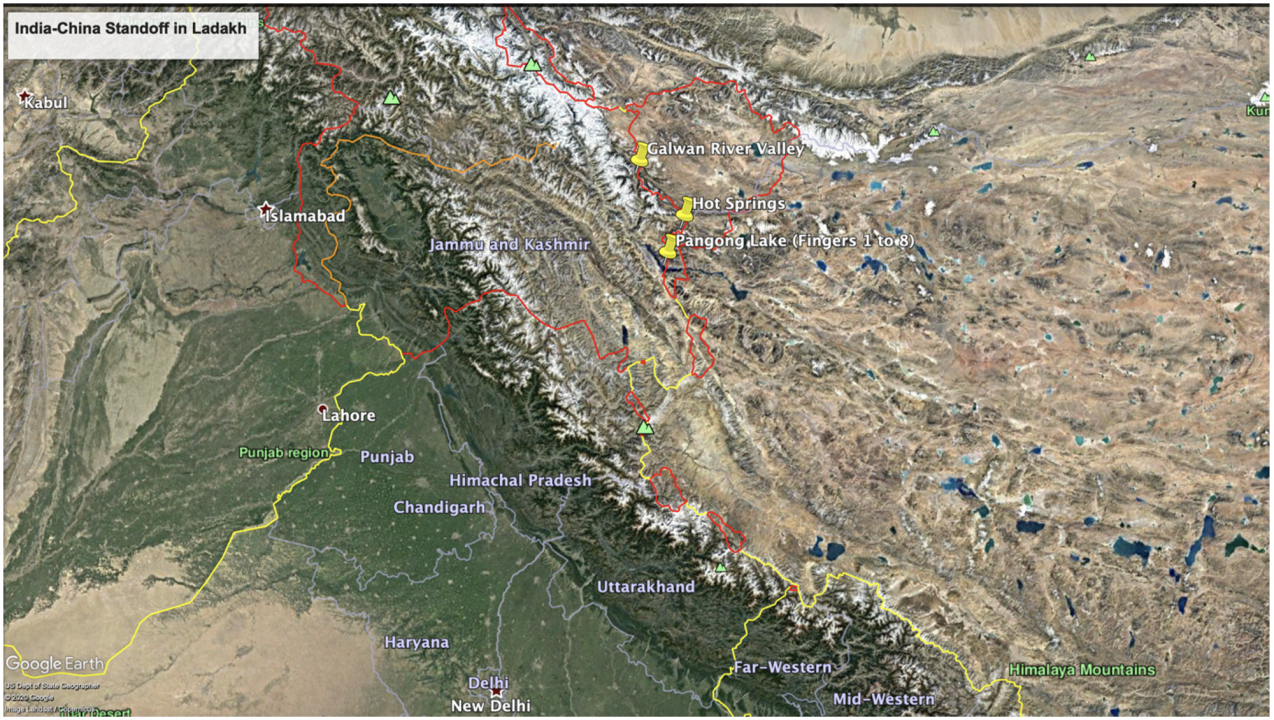
In the immediate aftermath of the incident, government officials in New Delhi and Beijing emphasized de-escalation and diplomatic engagement in public, while increasing troop deployments and speeding up construction of strategic infrastructure along the LAC. Popular social media platforms, meanwhile, became inundated with mis- and disinformation regarding the extent of the hostilities.
Shortly after, Indian fact-checking outlets AltNews and BoomLive published pieces highlighting how social media users and some domestic publications furthered rumors by publishing old and misleading photos and videos. Some of the false reports that circulated included claims of Indian border police capturing Chinese soldiers, exaggerated accounts of Indian troop casualties in clashes with Chinese forces, unsubstantiated claims regarding the number of Chinese casualties in the Galwan River incident, and videos of US Apache helicopters presented as Indian army activity in Ladakh.
Verifying the true extent of hostilities between Indian and Chinese troops was complicated by the mountainous and remote nature of the terrain in the region, as well as the fact that large sections of the border are closed to the press and the public. The informational vacuum created by a lack of credible reporting from the ground, as well as increased public interest in the ongoing border dispute, allowed mis- and disinformation in the form of old and misleading photos, videos, and satellite imagery to thrive.
Exaggerated accounts of troop injuries
On May 31, 2020, two anonymous Twitter accounts, @Oedosoldier and @dafengcao, posted an undated and unverified photograph that purportedly showed injured Indian border guards who had allegedly been captured by the Chinese People’s Liberation Army (PLA) along the LAC.
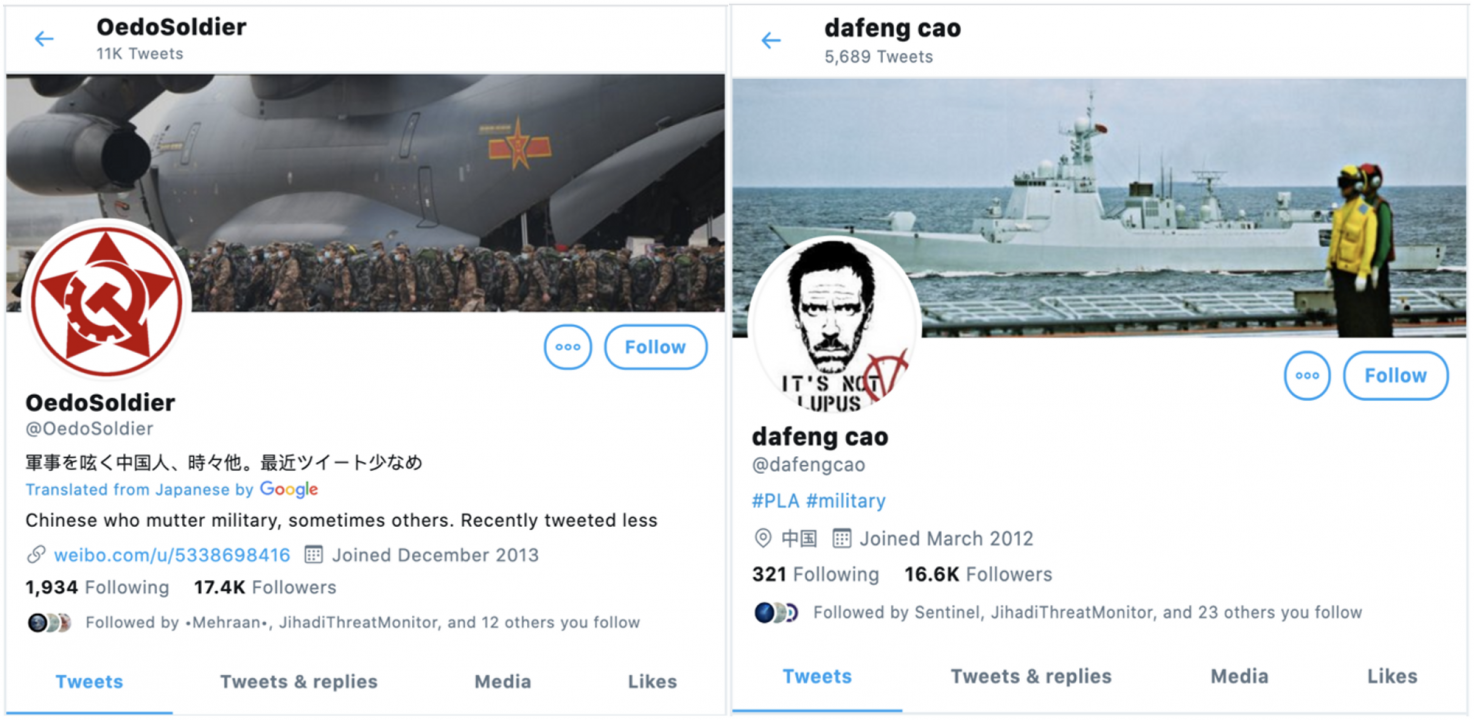
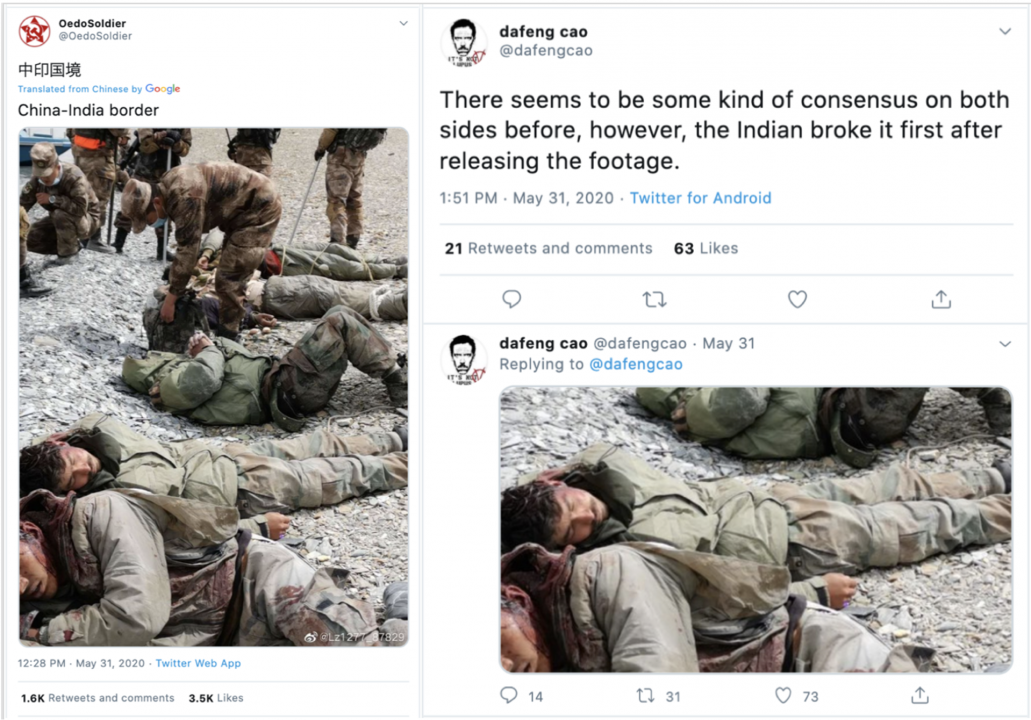
Before the authenticity of the video could be verified, the image went on to be widely amplified on a range of platforms, accruing thousands of likes and shares.

A User ID at the bottom of the photograph suggested that the photo had been sourced from Weibo, a popular Chinese social media platform, before crossing over to Twitter, which is largely inaccessible in mainland China. In an interview with India Today, an Indian army spokesperson denied the video represented a recent incident, saying that the “content of the video being circulated was not authenticated” and that attempts to “link it with the situation on the northern border were malafide.”
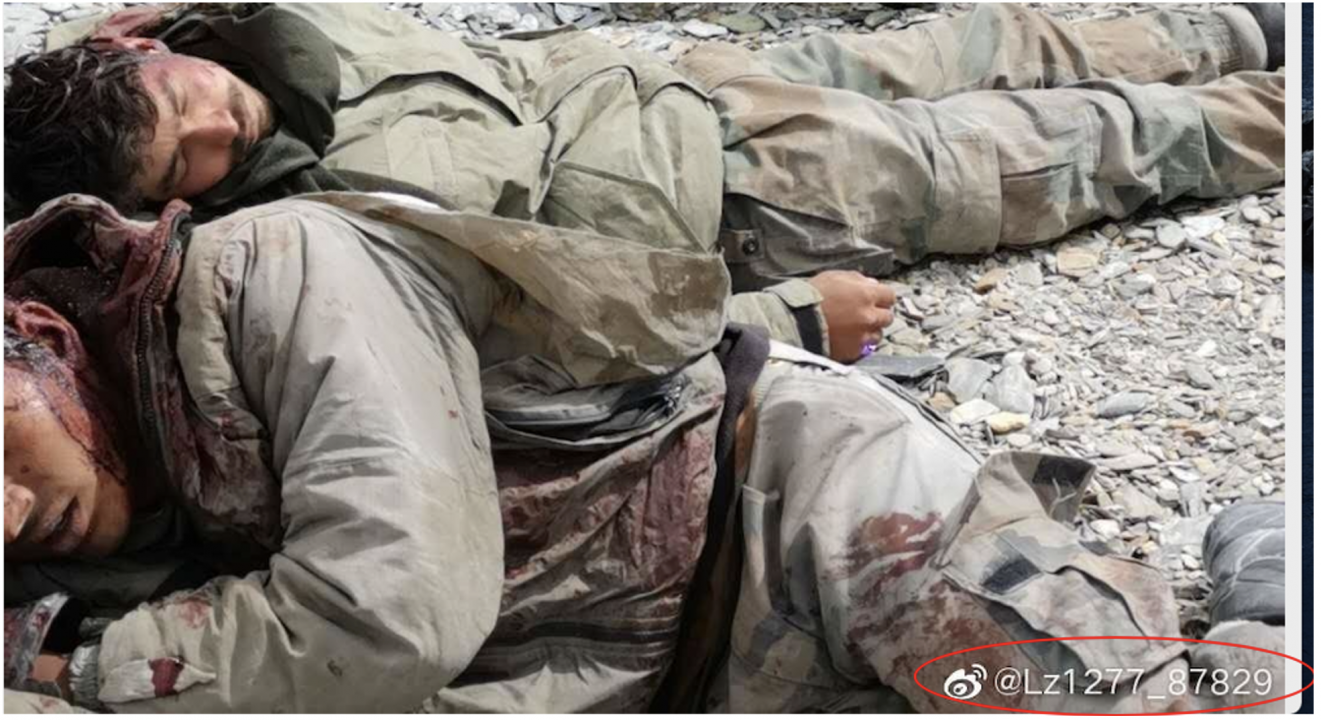
An investigation into Chinese influence operations on Twitter by ProPublica discovered that in recent years Chinese officials have increasingly leveraged the platform to spread disinformation aimed at influencing Chinese diaspora, Westerners, and other users around the world.
False claims of captured troops
Another viral claim propagated by Indian social media accounts was an old video that spread on major social media platforms in the days following the violent June 2020 border confrontation. The video purported to show Indian soldiers confronting a Chinese patrol car in disputed territory. The video is recorded from the perspective of the Indian soldiers, who appear to be pelted by stones and other unidentified objects thrown from off-screen. Facebook posts and tweets sharing the video used the exact same caption to spread the false allegation that Indian troops captured a “Chinese vehicle and a soldier” in retaliation for the Galwan River incident. AltNews investigated the claims and discovered that the video depicted a violent confrontation between both sides in May, one month before the Galwan River clash.
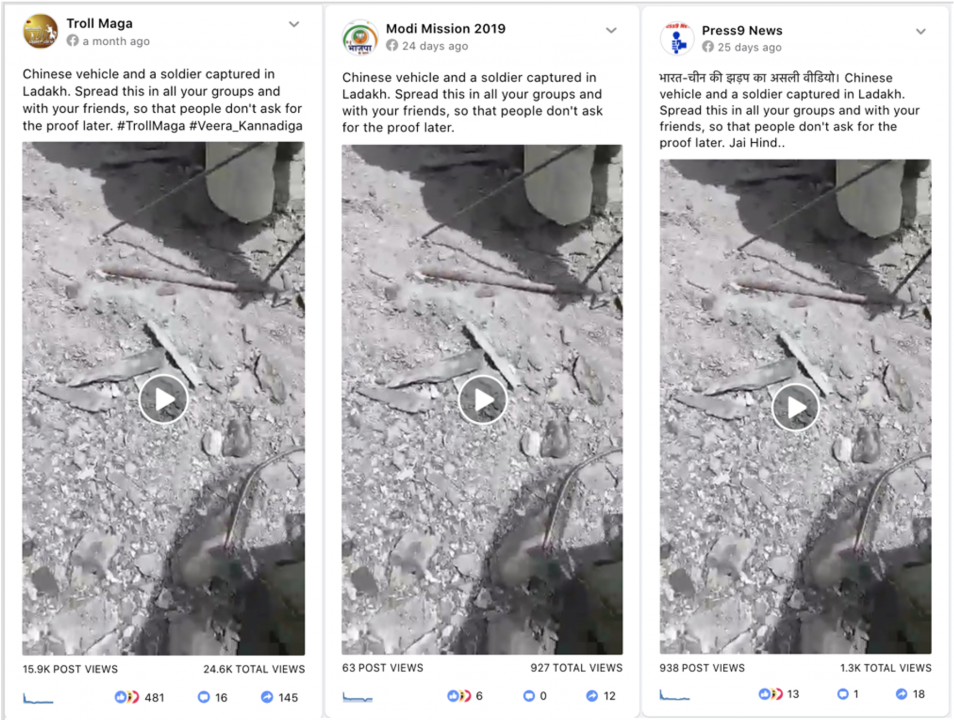
Shortly after, another old and undated video depicting clashes between Indian and Chinese troops along the LAC went viral on multiple social media platforms, with its release coinciding with de-escalation talks between Indian and Chinese military officials.

In both cases, despite being debunked by domestic fact-checking outlets, the falsehoods managed to accrue tens of thousands of views, highlighting the uphill task faced by those attempting to counter the spread of mis- and disinformation online.
Deploying inauthentic and sockpuppet accounts
Other users created sock puppet accounts impersonating independent experts and prominent foreign politicians to spread false and misleading narratives targeting Indian social media users over the course of the border crisis. Sockpuppet accounts refer to those that masquerade as somebody other than the actual operator, often with an overt intent to deceive.
A notable example of this activity is provided by @CRolanova, an inauthentic and anonymous Twitter account that impersonated a female Russian open-source intelligence expert affiliated with St Petersburg University in Russia, which posted false content designed to inflame sentiment around the conflict. The account was created on May 30, 2020, around the same time as media reports of heightened hostilities between Indian and Chinese troops began to emerge. The disinformation furthered by @CRolanova likely provoked confusion and alarmism from Indian viewers on the platform.
For example, the operator posted an old image of an injured soldier the day after the Galwan River incident in a way that implied the injury to be contemporary when in fact it showed a solider affected by COVID-19. The account also amplified a series of false and partisan narratives providing an exaggerated account of Chinese military activity in Indian-claimed territory.
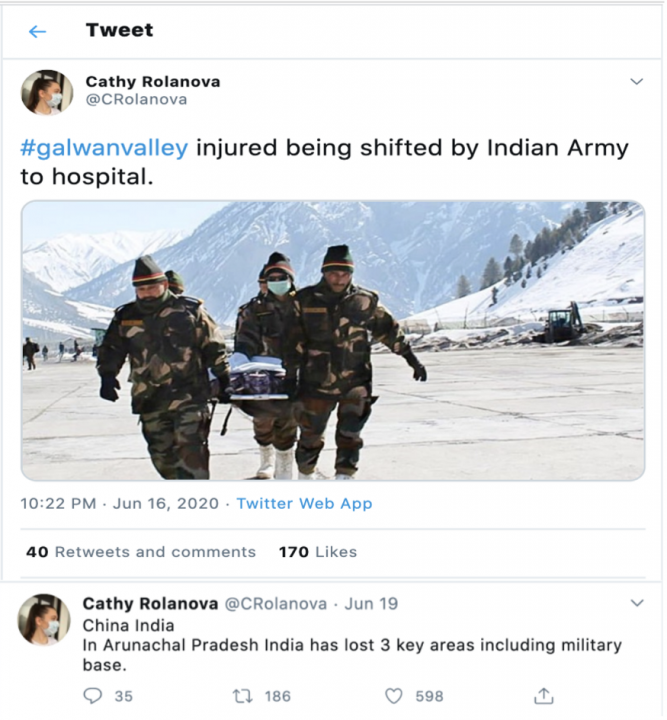
A reverse image search of the profile picture using Yandex, a Russian search engine, suggested that the @CRolanova account’s profile photo had been taken from the social media profile of Petri Katerina, the owner of a Moscow-based luxury fashion brand.
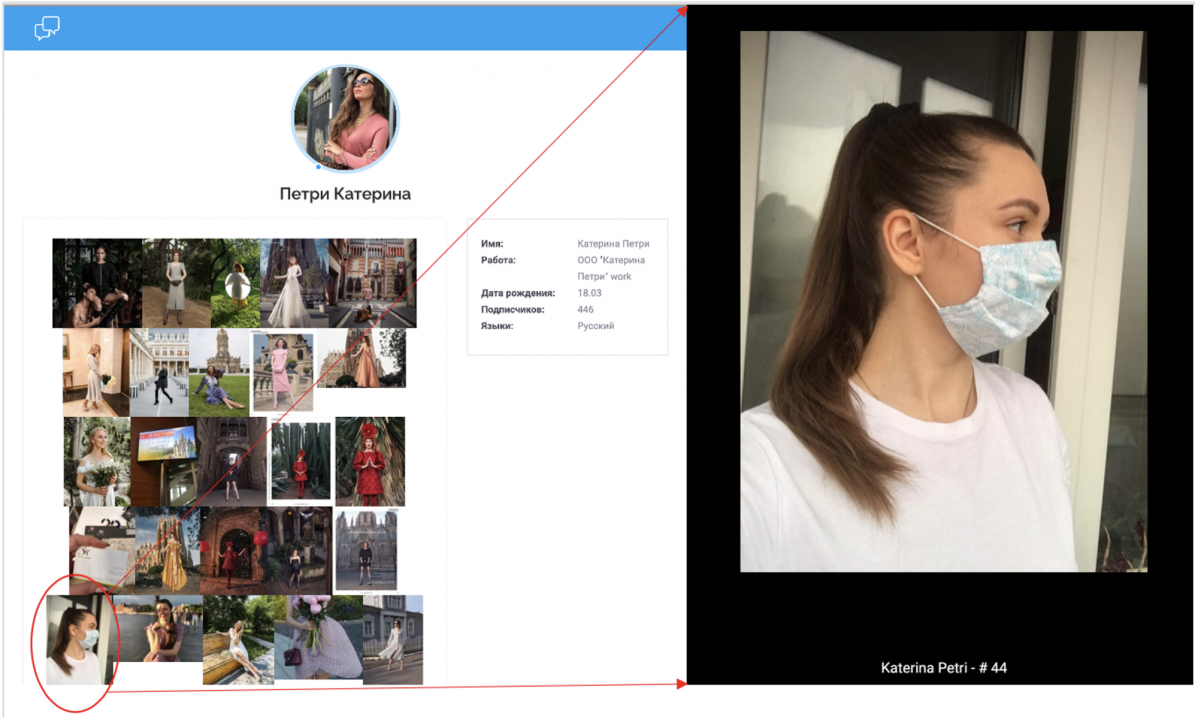
The account’s profile once contained a link to St. Petersburg’s University, but a search for Cathy Rolanova on the university website yielded no results.
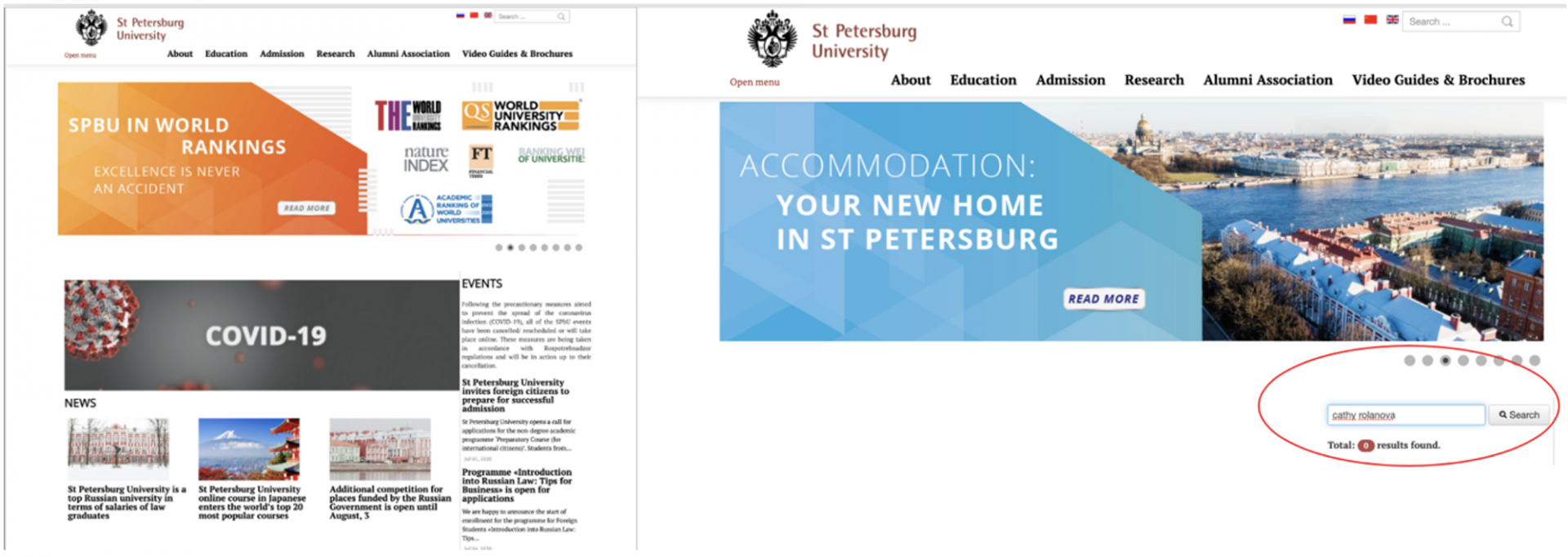
The account subsequently updated the account bio, replacing the link to the Russian university with another amplifying “SourceOSINT” a public channel on Telegram, an encrypted messaging service.
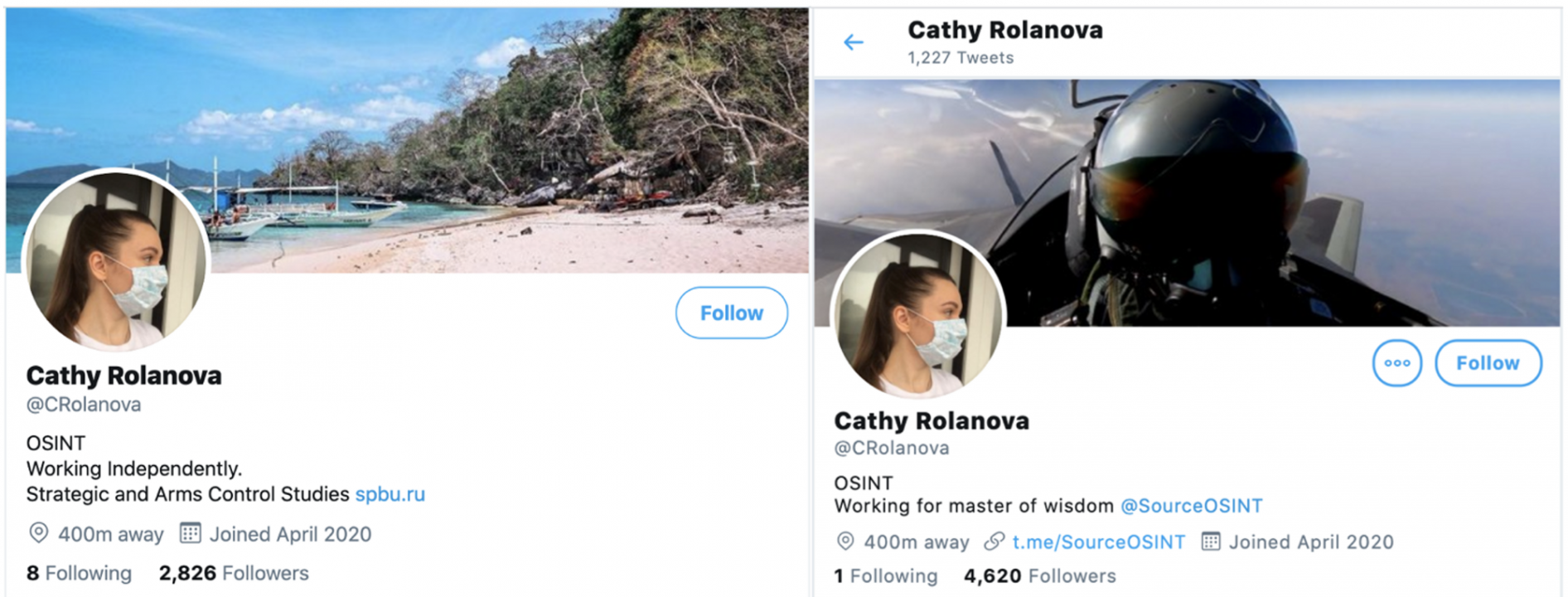
The Telegram channel was created on June 3, 2020, and there was no account activity or chat history, providing possible evidence of the user engaging in inauthentic behavior on the platform.

Further analysis into the account activity via Allegedly (Make Adverbs Great Again) and Twitonomy, two open-source social media analysis tools, provided some evidence of a cyborg account with the account posting at consistently regular intervals over a significant period of time, suggesting automation or the use of a social media scheduling software.
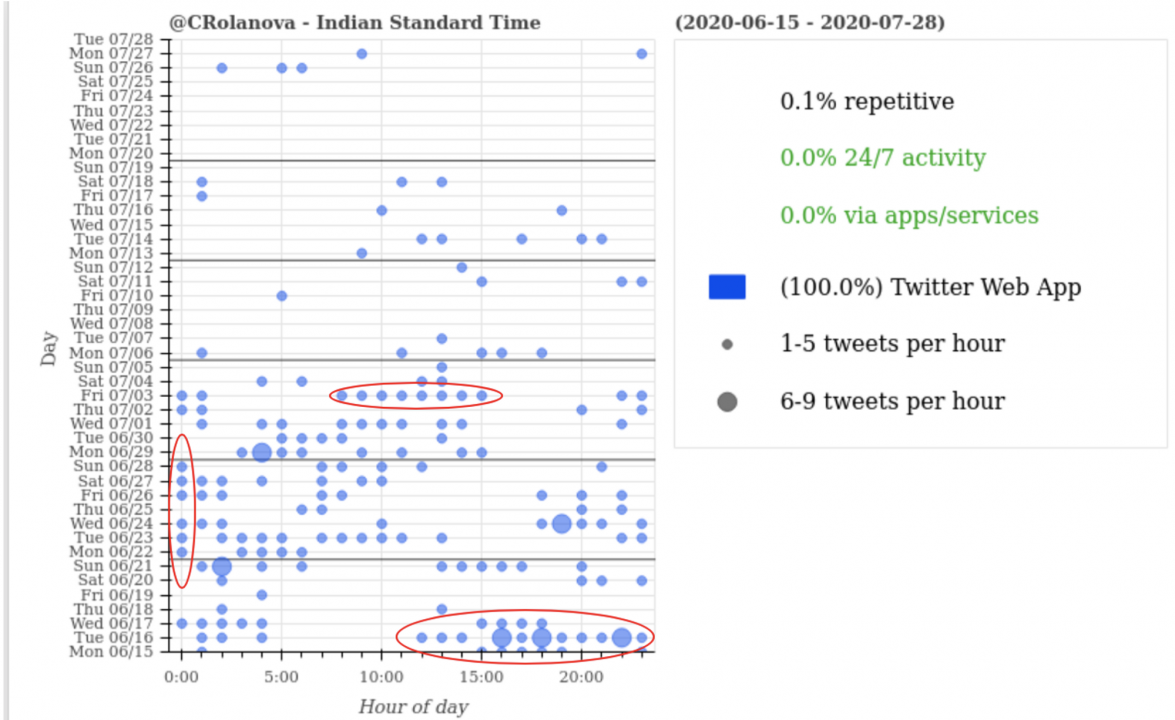
A Twitonomy heat map of the daily account activity supported this hypothesis, revealing that the account posts 24-hours a day, every day of the week, with no down time; an authentic user would not be able to maintain such a schedule.

Social media and security dilemma dynamics
In the context of China-India relations, the challenges posed by the mutual insecurity are particularly acute given that the LAC is an intrinsically contested border, insofar as its construction is hostage to differing and directly contradictory political perspectives, espoused by government officials in India and China, and exerted through conventional deployment of military forces and physical border infrastructure along the contested frontier.
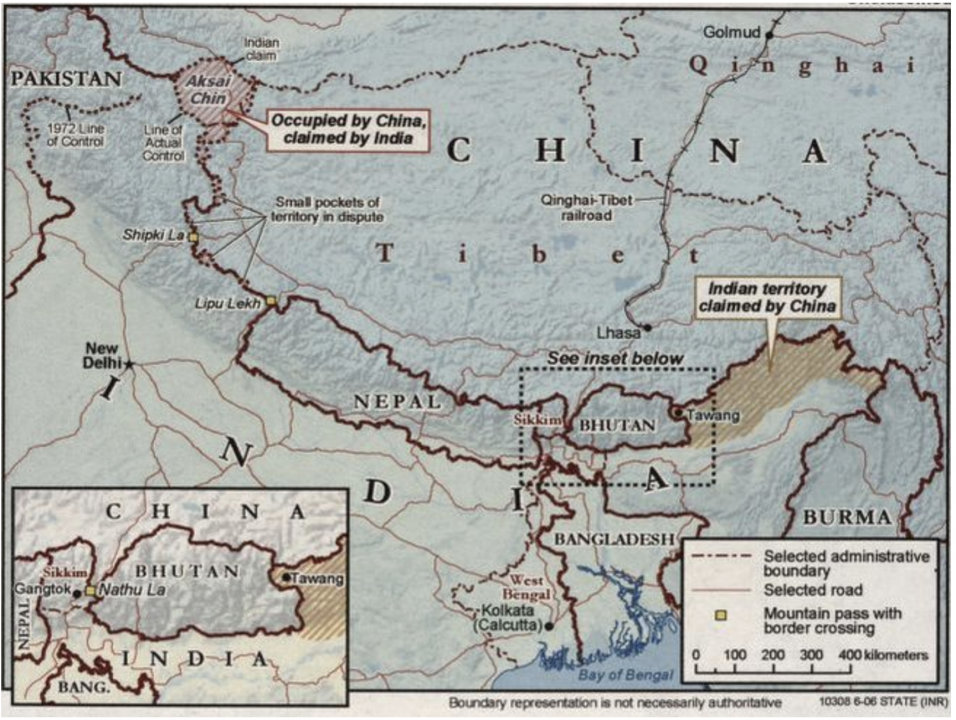
The Washington Post published an article on June 16 arguing that increased public pressure placed on Chinese and Indian politicians following the dispute could provide a pathway to war, while also making it difficult for the leaders at the helm in New Delhi and Beijing to de-escalate, warning that “public pressures have exacerbated Sino-Indian conflicts in the past.”
The presence of Chinese military troops near disputed territory, from April 2020 onwards, raised alarm in Indian policymaking circles, with Indian intelligence assessments concluding that PLA intrusions had likely been pre-planned for months and were authorized via a mobilization order issued by Chinese President Xi Jinping.
In an interview with The Hindu, former National Strategic Advisor Shivshankar Menon underlined the growing suspicion and hostility amongst Indian officials due to Chinese actions at the border, arguing that the standoff constituted a “significant change in Chinese behavior” that “calls into question the whole structure of agreements and confidence-building measures that were put in place… which had kept the peace on the border for some time.” Menon added, “I am sure India-China relations will have to be reset after this.”
The rise of anti-China sentiment in India in the aftermath of the Ladakh border dispute is thought to have been behind Prime Minister Narendra Modi’s decision to institute a ban on 59 Chinese-owned apps for “engaging in activities which are prejudicial to the security and integrity of India.” New Delhi’s decision mirrors tactics used by Beijing when it comes to US technology companies, with the Communist Party of China restricting or banning access to major social media platforms such as Facebook, Twitter and Instagram.
The challenges presented in such a contested digital sphere could magnify over time as conventional military conflict evolves with the digital age. National security has evolved as nation states co-opt popular communication platforms for their information warfare strategies, leading to a de-stabilizing effect on existing intra-national disputes and conflicts across the globe.
Since the Galwan River clash, the BBC has reported on several new influence operations that used misleading or undated media pertaining to the Sino-Indian border dispute. In addition to the case studies analyzed by the DFRLab, subsequent information operations have also coincided with, or sought to manipulate, perceptions around ongoing diplomatic operations being conducted by India and China’s armed forces.
On October 10, 2021, as Indian and Chinese commanders met for the 13th round of Corps Commander level talks, aimed at resolving the ongoing border dispute, some Indian accounts amplified still images from an Indian movie as evidence of PLA soldiers being apprehended by Indian troops. The images were released following local media reports of renewed clashes in the northeastern state Arunachal Pradesh. In retaliation, a journalist working for the Chinese-owned media outlet Global Times, uploaded an undated video on Twitter that purported to show PLA soldiers escorting Indian troops and claimed that it was taken during the recent stand-off. The DFRLab ran a reverse image search using multiple stills taken from the video but was unable to find where the video originated from.
Conclusion
The rapid proliferation of false and exaggerated narratives during a border crisis provides malicious actors with the means of influencing the national debate as well as instigating hyper-nationalist sentiment among a target population. This rise in nationalist sentiment amongst populations may in turn exacerbate the tensions along the border in the event of a future conflict, providing the impetus for officials to pursue an increasingly bellicose and confrontational foreign policy towards one another. Within such a tense environment, the amplification of viral falsehoods on social media greatly increases the likelihood of miscalculation and conflict between the nuclear armed neighbors over the long term.
The Ladakh border dispute also assumes increased geopolitical significance within the context of a marked changed in the balance of power dynamics between New Delhi and Beijing that carry broader consequences South Asian regional security and information integrity. In particular, the growing asymmetry in economic and military power held by China over its regional rival, coupled with Beijing’s assertive approach to foreign affairs, including the imposition of a contentious security bill in Hong Kong, military expansionism in the South China Sea, as well as the resurrection of latent border disputes with Bhutan represent powerful factors contributing towards a more insecure regional environment that will also be highly susceptible to inter-state conflict ignited by false and exaggerated narratives spread online.
Cite this case study:
Ayushman Kaul, “Social media and security dynamics in the ongoing India-China border dispute,” Digital Forensic Research Lab (DFRLab), January 6, 2022, https://medium.com/dfrlab/social-media-and-security-dynamics-in-the-ongoing-india-china-border-dispute-14d5bfb35f52.

